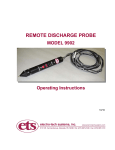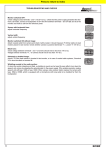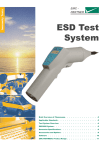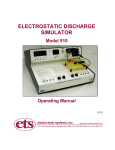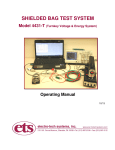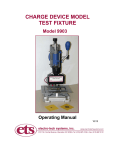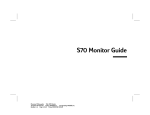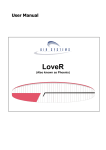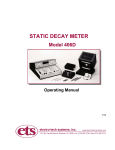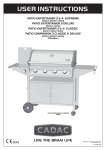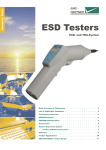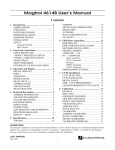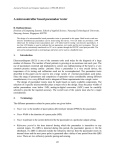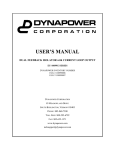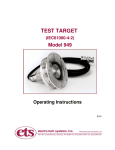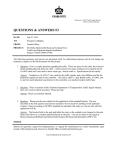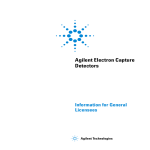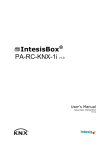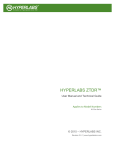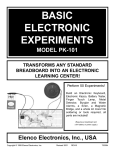Download 930D & 930D-FTS User Manual
Transcript
ELECTROSTATIC DISCHARGE SIMULATOR Model 930D & 930D FTS Operating Manual 5/11 IMPORTANT SAFETY INSTRUCTIONS (Equipment containing HV) The equipment described in this Manual is designed and manufactured to operate within defined design limits. Any misuse may result in electric shock or fire. To prevent the equipment from being damaged, the following rules should be observed for installation, use and maintenance. Read the following safety instructions before operating the instrument. Retain these instructions in a safe place for future reference. POWER POWER CORD: Use only the power cord specified for this equipment and certified for the country of use. If the power (mains) plug is replaced, follow the wiring connections specified for the country of use. When installing or removing the power plug hold the plug, not the cord. The power cord provided is equipped with a 3-prong grounded plug (a plug with a third grounding pin). This is both a safety feature to avoid electrical shock and a requirement for correct equipment operation. If the outlet to be used does not accommodate the 3-prong plug, either change the outlet or use a grounding adapter. FUSES: Replace fuses only with those having the required current rating, voltage and specified type such as normal blow, time delay, etc. DO NOT use makeshift fuses or short the fuse holder. This could cause a shock or fire hazard or severely damage the instrument. POWER LINE VOLTAGE (MAINS): If the line (mains) voltage is changed or isolated by an autotransformer the common terminal must be connected to the ground (earth) terminal of the power source. OPERATION CAUTION Equipment designed to simulate a high voltage electrostatic discharge such as the Series 900 ESD Simulators and the Model 4046 Static Decay Meter utilize voltages up to 30kV. The basic nature of an ESD event will result in electromagnetic radiation in addition to the high level, short duration current pulse. Therefore, personnel with a heart pacemaker must not operate the instrument or be in the vicinity while it is being used. DO NOT OPERATE WITH COVERS OR PANELS REMOVED. Voltages inside the equipment consist of line (mains) that can be anywhere from 100-240VAC, 50/60Hz and in some equipment, voltages as high a 30kV. In addition, equipment may contain capacitors up to 0.035 μF charged to 30kV and capacitors up to 0.5 μF charged up 6kV. Capacitors can retain a charge even if the equipment is turned off. DO NOT OPERATE WITH SUSPECTED EQUIPMENT FAILURES. If any odor or smoke becomes apparent turn off the equipment and unplug it immediately. Failure to do so may result in electrical shock, fire or permanent damage to the equipment. Contact the factory for further instructions. 1 DO NOT OPERATE IN WET/DAMP CONDITIONS: If water or other liquid penetrates the equipment, unplug the power cord and contact the factory for further instructions. Continuous use in this case may result in electrical shock, fire or permanent damage to the equipment. DO NOT OPERATE IN HIGH HUMIDITY: Operating the equipment in high humidity conditions will cause deteriation in performance, system failure, or present a shock or fire hazard. Contact the factory for further instructions. DO NOT OPERATE IN AREAS WITH HEAVY DUST: Operating the equipment in high dust conditions will cause deteriation in performance, system failure, or present a shock or fire hazard. Contact the factory for further instructions. DO NOT OPERATE IN AN EXPLOSIVE ATMOSPHERE: Operating the equipment in the presence of flammable gases or fumes constitutes a definite safety hazard. For equipment designed to operate in such environments the proper safety devices must be used such as dry air or inert gas purge, intrinsic safe barriers and/or explosion-proof enclosures. DONOT USE IN ANY MANNER NOT SPECIFIED OR APPROVED BY THE MANUFACTURER: Unapproved use may result in damage to the equipment or present an electrical shock or fire hazard. MAINTENANCE and SERVICE CLEANING: Keep surfaces clean and free from dust or other contaminants. Such contaminants can have an adverse affect on system performance or result in electrical shock or fire. To clean use a damp cloth. Let dry before use. Do not use detergent, alcohol or antistatic cleaner as these products may have an adverse affect on system performance. SERVICE: Do not attempt to repair or service the instrument yourself unless instructed by the factory to do so. Opening or removing the covers may expose you to high voltages, charged capacitors, electric shock and other hazards. If service or repair is required, contact the factory. 2 1.0 INTRODUCTION The Model 930D Electrostatic Discharge Simulator is an instrument that is designed to simulate the discharge produced by an electrostatically charged human body when it is brought close to an object that is at a lower potential. By use of additional R-C modules and probes, the Discharge Simulator can also simulate the effects of other types of discharges such as a person holding a metal object as defined in EN 61000-4-2 (formerly IEC 1000-4-2/801-2 and IEC 801-2). In addition, with appropriate R/C networks and output cables the Simulator can test to MIL STD 1512, 1576, 331C, MIL-DTL 23659D etc. Static charges are generally created when dissimilar objects are brought into contact with each other and then separated. When this situation occurs, electrons are transferred from one object to the other. If these objects are electrostatically conductive (i.e., have surface resistivities of less than 1012 ohms per square) and are both connected to a third conductive body or to each other, the built-up static charge will flow from one body to the other in a short time. The resulting net charge build-up will be zero. If, on the other hand, these same electrostatically charged objects are separated by an insulator, the charge build-up may not be neutralized and each body may retain its charge for a long time, particularly in a low humidity environment. The charging of objects due to relative motion is known as the Triboelectric Effect and can produce voltages from a few Volts to tens of thousands of Volts. The charge build-up depends on many factors including the amount and rate of motion, the composition of the materials involved, the secondary surfaces involved (floor, table top, air, etc.), the relative humidity level of the air surrounding the charged bodies and surface coatings used on any of the surfaces (if any). When a highly charged body is brought near an electrostatically neutral body or one that has an opposite charge, a rapid discharge can occur. In many cases, this discharge is nothing more than an annoyance; however, in some cases the discharge can result in the disruption of an industrial process, the loss of valuable data, damage to sensitive components or an explosion that can result in injury and/or the loss of life. One of the most common types of electrostatic build-ups occurs with the flow of people and material over nonconductive surfaces. Humidity conditions usually determine how static dissipative a surface is. The lower the humidity, the longer the static charge dissipation of a nonconductive material. A person walking across a carpet or tile floor on a dry day is capable of generating an electrostatic body charge in excess of 15,000 Volts. When the person comes in contact with an electrostatically conductive object, he immediately discharges the accumulated charge on his body. If the charge build-up is about 3,000 Volts, the person will feel only a slight shock. However, if the charge build-up is much larger, a visible spark discharge will occur that can cause not only discomfort to the person but possible damage to the item contacted. In the past, electrostatic discharges were generally of less concern than they are today. With the introduction of more and more synthetic materials, many of which are easily charged, and the development of complex electronic equipment that may contain electrostatic discharge sensitive components, the effects of electrostatic discharge have become a major concern. Many electronic components can be damaged or destroyed when subjected to electrostatic discharges of less than 100 3 Volts. Discharges of tens of thousands of Volts can have devastating effects on such things as electronic communication systems, medical electronic systems, computers and home entertainment systems. It is virtually impossible to control the environment in which most of today’s high technology equipment is used. The burden falls on the manufacturer to design and build equipment that can function without disruption or failure when subjected to commonly occurring electrostatic discharges. The Model 930D Electrostatic Discharge Simulator can be an invaluable aid in helping to develop and test equipment so that it can function reliably in today’s military, industrial and consumer environments. While the Model 930D is primarily designed for testing systems it can also be adapted to test components meeting waveform requirements in accordance with Mil Std 883, Method 3015, ESD STM5.1 (HBM) from 500 to 26,000 V and 5.2 (MM) from 100 to >800 V plus the capability to perform charged device model tests (CDM) up to 26 kV. Waveform verification is performed using an IEC test target (ETS Model 949). 2.0 EQUIPMENT DESCRIPTION 2.1 General The Model 930D Electrostatic Discharge Simulator can produce discharge pulses from <±100 Volts to >±26kV. Energy is stored in a plug-in selfcontained capacitor bank during the charging period. A discharge pulse is produced when a high voltage gas filled relay disconnects the charged capacitor bank from its charging source and reconnects it to the output electrode of the Discharge Simulator Gun in the RELAY mode. In the AIR DISCHG (DISCHARGE) Mode the relay remains closed as long as the trigger or DISCHARGE button is depressed. The discharge occurs when the operator brings the ESD gun up to the System Under Test (SUT). The energy storage capacitor bank and discharge resistor are contained in either individual plug-in modules or in a common module, depending on the R/C model specified. Capacitor and resistor modules are selected by the user and must be ordered at the time of purchase to configure the initial system. Standard and custom modules are available with capacitor values ranging from 60pf to 500pf and resistor values ranging from 100 to 10,000 ohms. Contact ETS for capacitor modules above 500pf. Figure 2.1a and b are typical HBM and IEC waveforms. The following resistor and capacitor modules are some of the common networks currently in use along with the corresponding discharge waveforms: R ohms 1,500 150 330 2,000 10,000 0 5,000 4 C pF Mode Waveform 100 150 150 300 60 500 500 Relay Air Relay Relay Relay Relay Relay A A B B A A A Application Discharge from Human Body EN 61000-4-2 EN 61000-4-2 Automotive Industry Telephone Industry Explosives Explosives a b Figure 2.1-1: Typical EDS Waveforms All “A” waveforms are produced when the capacitor only is contained within the CAPACITOR module and the resistor is contained in the RESISTOR assembly that is plugged into the nose of the ESD Simulator. All “B” waveforms are produced when both the capacitor and resistor are contained in the CAPACITOR module and a “0” Ohm resistor is plugged into the nose. This configuration is generally referred to as the IEC style waveform. All waveforms are obtained using an IEC specified test target (ETS Model 949). The principle of operation of the discharge simulator is illustrated in Figure 2.1-1. Figure 2.1-1 Simplified Block Diagram The Electrostatic Discharge Simulator, shown in Figure 2.1-2, is contained in two (2) parts: a Control Unit and a Gun Assembly. The two units are interconnected by a detachable 15-pin sub D cable. The system shown in Figure 2.1-3 is the Model 930D FTS. The FTS (Firing Test Set) is identical to the Model 930D except the Gun Assembly is modified for mounting in a fixed position, instead of being hand held that provide for air, continuous or automatic discharge pulse generation. In the AIR DISCHG mode the gun tip is charged and then brought up to the SUT until a discharge occurs. In the RELAY mode, the discharge to the SUT is produced by the relay closure. In FREE RUN, the system will continue to produce discharge pulses as long as the OPERATING MODE switch is in the AUTO Trigger position. The dwell 5 time or charging period between discharge pulses is adjustable by the user from 1/3 second to about 20 seconds. In Auto Count, the user selects the number of discharge pulses desired (1 to 9) and then either depresses the Gun Trigger pushbutton or activates the AUTO Trigger Switch. The Discharge Simulator will then produce the selected number of pulses at the selected time interval between pulses. A single digit numeric readout displays the number of pulses from 1-9 produced. When the Trigger Switch is released or the AUTO Trigger is turned off, the system counter resets to zero and the production of HV output pulses stops. The discharge pulse sequence is repeated each time either the MANUAL or AUTO Trigger Switch is activated. Figure 2.1-2 Model 930D Electrostatic Discharge Simulator Figure 2.1-3 Model 930D FTS 6 The control unit has a duplicate set of controls for remote gun operation. A High Voltage On/Off Switch, located on the Gun, and an ARM switch, located on the Control Unit, are provided to help avoid the generation of accidental discharge pulses. An assortment of different electrodes are available to enable the user to configure the discharge tip of the Gun, as required, to simulate various types of discharges. NOTE: The Model 930D and 930D FTS can be customized to meet specific customer requirements. Refer to the Appendix for instructions pertaining to these modifications. 2.2 Controls 2.2.1 Control Unit Figure 2.2-1 shows the Control Unit front panel. 2.2.1.1 A/C Power ON/OFF This push-push switch controls the AC power input to the unit. When power is on, the four (4) LED POWER ON indicators on the front panel will be illuminated. 2.2.1.2 DISCHARGES SELECT Switch This is a ten (10) position rotary switch that is used to select the number of discharge pulses the system will produce when the system is in the AUTO COUNT Mode and the Trigger Switch is placed in either run position. When the DISCHARGES SELECT Switch is in the 0 position, the unit will be inhibited from producing discharge pulses regardless of the position of the Gun or Remote Trigger Switch. When set to position 1, the system will produce only one (1) pulse each time the Trigger Switch is activated, thus making “single shot” operation possible. The DISCHARGES SELECT Switch setting is ignored by the system when the AUTO COUNT/FREE RUN Switch is in the FREE RUN position. 2.2.1.3 AUTO COUNT/FREE RUN SELECT Switch This 2-position toggle switch programs the system for either FREE RUN or AUTOMATIC operation. When this switch is in the FREE RUN position, the DISCHARGES indicator is off (not illuminated) and the system will continue to produce discharge pulses as long as the Trigger Switch is in either of its two run positions. When in the AUTO COUNT position, the DISCHARGES display will be illuminated and the system will produce the number of discharge pulses programmed by the setting of the DISCHARGES SELECT Switch each time the Gun Trigger Switch is placed in a RUN position. 7 2.2.1.4 RANGE This 2-position toggle switch selects either the LO or the HI Range. In the LO position the usable voltage range is <.100 V to >3.00kV and in the HI position the usable voltage range is 3.00 to 26 kV (minimum). Figure 2.2-1 Model 930D Control Unit 8 2.2.1.5 HIGH VOLTAGE ADJUST Control This rotary control is used to set the level of the high voltage supply to the desired charging voltage. The voltage level is indicated by the reading on the CHARGING VOLTAGE METER. The HIGH VOLTAGE ADJUST control is set prior to initiating a discharge sequence. The HV ON Switch must be turned on in order to make this adjustment.. The charging voltage level increases as this control is rotated in the clockwise direction. NOTE: Starting with Serial # 262, the HV ADJUST control has been changed from a single turn potentiometer to a multi-turn (10x) potentiometer. This allows more precise voltage adjustment at the higher voltages. All other functions remain the same. 2.2.1.6 INTERVAL ADJUST Control This rotary control allows the operator to set the time interval between discharge pulses. This interval is adjustable from a minimum of 1/3 second to over 20 seconds. Rotating the control clockwise increases the time interval between discharge pulses. 2.2.1.7 REMOTE 2.2.1.7.1 ARM This 2-position toggle switch is used to turn the High Voltage off when in the OFF position and ON when it is in the ARM position. The Amber LED will light when the system is armed. This switch must be in the ARM position to use the system. 2.2.1.7.2 REMOTE TRIGGER This 3-position toggle switch parallels the AUTO/MANUAL and push button TRIGGER buttons located on the gun. In the center position no discharge pulses are initiated. In the AUTO position the gun will produce the selected number of discharges or free run. In the MANUAL position, which is spring loaded, the above discharge limitation will occur as long as the operator holds the switch. The System automatically resets to zero when the switch is released. The Green LED will flash each time a discharge occurs. 9 2.2.2 Gun Unit The Gun unit with Trigger Switch positions is shown in Figure 2.2-2 2.2.2.1 AIR/RELAY DISCHARGE Switch The 2-position toggle switch selects either the AIR discharge mode or the RELAY discharge mode. 2.2.2.2 TRIGGER Switch This pushbutton switch is used by the operator to manually activate the relay to generate discharge pulses. When depressed by the operator, the correct discharge sequence will be initiated and maintained as long as the switch is held in. The system automatically resets to ZERO when the switch is released. Figure 2.2-2 Gun Trigger Switch Positions 2.2.2.3 AUTO TRIGGER This 2-position rocker switch selects either manual discharge via the pushbutton Trigger Switch or the AUTO Mode whereby the unit will produce discharges without any additional operator function. When in the AUTO TRIGGER Mode, the Green LED will flash and the system will produce the correct discharge sequence previously selected. 2.2.2.4 HV ON This 2-position rocker switch turns the High Voltage on and off. To produce a discharge, the switch must be turned on in 10 addition to the ARM switch on the control unit. High Voltage ON is indicated by a yellow LED. 2.3 Displays and Readouts 2.3.1 Control Unit 2.3.1.1 DISCHARGES Display This numeric display illuminates automatically when the AUTO COUNT/FREE RUN Mode Select Switch is in the AUTO COUNT position and is blanked out when it is in the FREE RUN position. It resets to zero when the Trigger Switch is in the OFF position and displays the discharge pulse count when the Trigger Switch is either depressed or the AUTO Trigger is turned on. When the discharges automatically stop in the AUTO COUNT Mode, the DISCHARGES Display will indicate the total number of pulses produced for that test sequence. The final count will agree with the discharge number set on the DISCHARGES SELECTOR Switch. 2.3.1.2 Power Supply Status Monitors The control panel contains four (4) colored point source indicators that monitor the voltages within the Discharge Simulator’s power supply. They also indicate the On/Off status of the AC power. When the AC power is on and the internal power supply is functioning properly, all four (4) indicators should glow brightly. If the AC power is off or the AC fuse is blown, all four (4) of the indicators will be off. If one or more of the power supply voltages within the simulator are malfunctioning, the appropriate indicator will glow dimly or will go out. Should a malfunction be suspected, consult the trouble shooting section of the manual or contact ElectroTech Systems. 2.3.1.3 RANGE INDICATORS These point source LEDs indicate the voltage range selected. The Green LED indicates the LO Range and the Red LED indicates the HI Range. 2.3.1.4 CHARGE/DISCHARGE Indicators These two point source indicators illuminate during the appropriate portion of the Charge/Discharge cycle. The Green CHARGE indicator will be illuminated when the ARM switch is in the ARM position and the Simulator is not producing a discharge pulse. The Red DISCHARGE indicator will light during the brief discharge time. Failure of either indicator to light at the appropriate time may be an indication of a system malfunction. 11 2.3.1.5 CHARGING VOLTAGE Meter This 4½-digit LED meter indicates the magnitude and polarity of the charging supply voltage directly in kilovolts. This meter reading is related to the magnitude of the discharge pulse produced when either Trigger Switch is activated. The energy stored in the capacitor bank may be calculated using this meter reading. The energy stored will be equal to ½ CV2, where C is the value of the storage capacitor and V is the charging voltage, as indicated by the meter. 2.3.2 Gun Unit 2.3.2.1 HV ON This Yellow point source LED indicator is located on the HV ON Switch and illuminates when the high voltage is turned on. 2.3.2.2 AUTO TRIGGER This Green point source LED is located on the AUTO TRIGGER Switch and illuminates when the Auto Trigger Mode is selected. 2.3.2.3 DISCHARGE This Red point source LED is located on the left-hand side of the Gun unit and illuminates each time the HV relay is activated. It remains on continuously as long as the Trigger Switch is activated in the AIR DISCHG mode. 2.4 Output Probe and Accessories 2.4.1 Output Probe This plug-in assembly consists of a series output limiting resistor and a discharge probe. The probe assembly is illustrated in Figure 2.4-1. The Output Probe plugs into the Gun output via a standard .080” pin plug. The standard output probes supplied are a 0.5” (12.5mm) IEC spherical electrode, an IEC point tip electrode and a standard banana jack. Figure 2.4-1: Standard Output Probes 12 2.4.2 Output Probe Accessories 2.4.2.1 Adjustable Spark Gap This accessory, illustrated in Figure 2.4-2, is used to fix the distance between the Discharge Probe and the SUT. An opening is provided for using a feeler gage to set the gap to the desired distance. A thumbscrew locks the unit in place. The length of the spark gap is adjustable. Figure 2.4-2: Variable Spark Gap NOTE: The Discharge Electrode should never be touched while the Discharge Simulator is on. 2.4.2.2 E-Field Plate (Optional) This accessory, illustrated in Figure 2.4-3, is used to simulate a pulse-type electrostatic field. It is secured to the STANDARD OUTPUT PROBE via its own 6-32 mounting stud after the spherical or IEC Probe Tip is removed. Figure 2.4-3: E-Field Plate 2.4.2.3 H-Field Loop (Optional) This accessory, illustrated in Figure 2.4-4, is used to simulate a pulsed magnetic field. The magnitude of the field is 13 determined by the level of the charging voltage and the value of the current output limiting resistor. It is secured to the standard output probe via a 6-32 threaded end after the spherical or IEC Probe Tip is removed. Figure 2.4-4 H-Field Loop 3.0 OPERATION 3.1 Initial Set-up 3.1.1 Control Settings Before connecting the Discharge Simulator to the AC line, set the controls to the following positions: 1. AUTO TRIGGER Switch: OFF position 2. HIGH VOLTAGE Adjust: Fully counterclockwise 3.1.2 Interconnecting Cable Connect the Gun to the Control Unit using the 12’ long interconnecting cable. The MALE (plug) end of the cable should interface with the connector on the panel of the Control Unit. Lock the connector in place by tightening the two (2) thumb-screw retainers on each end. After the cable has been attached, connect the Discharge Simulator to the AC line (90-240 VAC) using the power cord supplied with the system for North America. For other power outlets either use an appropriate IEC cord or cut off the North American plug and replace with the appropriate style. Turn the System ON by depressing the POWER pushbutton switch fully until a click is heard. If the indicators on the control panel illuminate, depress the power ON/OFF Switch to turn the AC power OFF. 14 3.1.3 Output Configuration Select the output probe and/or accessory as required by the testing requirements. With the AC power OFF, attach the probe to the high voltage output connector of the Gun as shown in Figure 3.1-1. When using the Model 930D to test components install the banana jack to the appropriate current limiting resistor and plug the Red output cable into the banana jack and the black ground cable into the capacitor module ground jack. Refer to Section 5.0 for connecting the Model 930D to the Model 910 DUT boards that are used for performing this test. Figure 3.1-1: Output Probe Installation NOTE: NEVER ATTEMPT TO CHANGE OR ADJUST ANY PART OF THE HIGH VOLTAGE OUTPUT CONNECTOR, OUTPUT PROBE OR ACCESSORY UNLESS THE HIGH VOLTAGE SWITCH IS TURNED OFF AND THE CHARGING VOLTAGE METER READS ZERO. THE ENERGY STORED WITHIN THE GUN IS SUBSTANTIAL AND CAN RESULT IN SERIOUS INJURY TO PERSONNEL IF THE OUTPUT TIP OF THE GUN IS NEAR OR IN CONTACT WITH A PERSON WHILE DISCHARGE OCCURS. 15 3.1.4 Safety Precautions The Model 930D Electrostatic Discharge Simulator has been designed to function safely and reliably; however, because of the nature of the output voltage improper use can result in serious injury to personnel and/or damage to components and equipment. Observe the following precautions when operating this unit: 1. Always plug the system into a grounded power outlet using the 3-wire AC cord furnished with the unit. If the system is not properly grounded, the entire unit will be electrically floating above ground and could produce an output that may injure the operator. 2. Never place the output probe near any part of a person’s body while the AC power is on or while the Gun is being activated. 3. Never attempt to change the output probe assembly with the high voltage on. 4. Always double-check the test set-up BEFORE turning on the high voltage and activating the Gun. 5. Always turn the ARM Switch and the HIGH VOLTAGE ON Switch to the OFF position when the system is not being used to produce output pulses. The internal high voltage power supply will be ON if the switches are left in the ON position. 6. When probing a System Under Test (SUT), always start at a low voltage level and work slowly upward. Never start testing at the full output level since damage to the SUT may occur. 3.2 Discharge Pulse Generation (RELAY DISCHG) 3.2.1 FREE RUN Mode 3.2.1.1 Mode Selection After the proper output probe has been installed and the test set-up double-checked, set the AUTO COUNT/FREE RUN Select Switch to the FREE RUN position. 3.2.1.2 Interval Adjustment Depress the Trigger Switch or the remote MANUAL discharge switch and hold it there. The Red DISCHARGE indicator will flash and an audible “click” will be heard. This indicates that the normal discharge cycle is occurring. While depressing the Trigger Switch, rotate the INTERVAL Adjust knob until the desired discharge repetition rate is achieved. Release the Trigger Switch. 3.2.1.3 High Voltage Level Adjustment Select the desired Range by pushing the RANGE Switch for the LO (<100-3,000V) or HI (3,000-26,000V) position. With the Trigger Switch in the OFF position, push the ARM Switch to ARM and the HV ON Switch to ON and rotate the HIGH 16 VOLTAGE ADJUST knob clockwise until the desired voltage level is indicated on the CHARGING VOLTAGE Meter. Effective with Ser# 262 this control is a 10-turn potentiometer. 3.2.1.3 Discharge Pulse Generation, Momentary Position To generate discharge pulses, depress either the Trigger Switch on the Gun or hold the Remote DISCHARGE Switch in the MANUAL position. The system will produce a continuous stream of output pulses at the selected rate and voltage level until the Trigger Switch is released. 3.2.1.4 Discharge Pulse Generation, AUTO Trigger Mode To use the AUTO Trigger Mode, PUSH the AUTO Trigger Switch either on the Gun or on the Control Unit. The Green LED on the Gun will light when the Gun Switch only is activated. The unit will continue to produce output pulses until the AUTO Trigger Switch is snapped back to its OFF position. 3.2.2 AUTO COUNT Mode 3.2.2.1 AUTO COUNT Mode Selection To operate the system in the AUTOMATIC COUNT Mode, place the AUTO COUNT/FREE RUN Switch in the AUTO COUNT position. The DISCHARGES display should illuminate and display a zero. Set the DISCHARGES SELECT Switch to position 9. 3.2.2.2 INTERVAL Adjustment Depress the Trigger Switch to place it in the momentary position and adjust the INTERVAL control to the desired discharge repetition rate. If the full count of 9 is reached before this adjustment is made, the unit will automatically stop. If this occurs, release the Trigger Switch, then depress it again. This action will reset the DISCHARGES display to zero and the system will produce another nine (9) pulses before it stops again. When the adjustment of the INTERVAL control has been completed, release the Trigger Switch to return it to the OFF position. 3.2.2.3 High Voltage Level Adjustment With the AUTO Trigger Switch in the OFF position, push the ARM Switch to ARM and the HV ON Switch to ON and rotate the HIGH VOLTAGE ADJUST control until the desired voltage level is indicated on the Charging Voltage Meter. DO NOT TOUCH EITHER THE MOMENTARY OR AUTO TRIGGER SWITCH WHILE THE HV LEVEL IS BEING ADJUSTED. Pushing either the ARM Switch or the HV ON 17 Switch to OFF will in turn disconnect the High Voltage Power Supply. 3.2.2.4 Discharge Pulse Count Selection To select the desired number of discharge pulses to be automatically produced, place the AUTO Trigger Switch in the OFF position, then rotate the DISCHARGES SELECT Switch to the desired number. NOTE: If the DISCHARGES SELECT Switch is set to zero, the generation of discharge pulses will be inhibited regardless of the position of the Trigger Switch. 3.2.2.5 Discharge Pulse Generation, MOMENTARY Trigger Switch Position To enable the Gun to produce discharge pulses at the voltage level set in 3.2.2.3 above, depress either the Trigger Switch on the Gun or the MANUAL Switch on the Control Unit. The Gun will produce the number of discharge pulses set on the DISCHARGES SELECT Switch and then will stop. If the Trigger Switch is released before the full count is reached, the DISCHARGES Display will reset to zero and the Gun will stop producing discharge pulses. The sequence will be repeated when the Trigger Switch is depressed. 3.2.2.6 AUTOMATIC Mode, AUTO Trigger Switch ON To produce discharge pulses without having to hold the Gun, secure the Gun in a holding fixture (a standard ¼-20 photographic tripod mount is provided), then push either the AUTO Trigger Switch on the Gun or the Remote Trigger Switch on the Control Unit. The Gun will produce the number of pulses set on the DISCHARGES SELECT Switch and will then stop. To repeat the discharge cycle and generate the same number of discharge pulses, flip the AUTO Trigger Switch to the OFF position then back to the ON position. 3.2.3 Single Pulse Operation To operate the Discharge Simulator such that only one (1) discharge pulse is produced each time the Trigger Switch is activated, place the system in the AUTO PULSE Mode and set the DISCHARGES SELECT Switch to 1. Adjust the INTERVAL and HV level as in 3.2.2.2 and 3.2.2.3. Each time the Trigger Switch is depressed or placed in the AUTO Trigger position, the Simulator will produce a single discharge pulse. 3.3 Discharge Pulse Polarity Selection The Model 930D Electrostatic Discharge Simulator is capable of producing either positive or negative discharge pulses. The polarity of the discharge 18 pulse is determined by the location of the H.V. Reversing module installed in the Gun. The polarity of the output pulse may be changed by simply removing the Polarity Reversing Module and rotating it 180° and then plugging it back in. To change high voltage polarity, use the following procedure: 1. Turn both the ARM Switch and the HV ON Switch to OFF and wait at least ten (10) seconds. The Trigger Switch should be in the OFF position. 2. Unplug the High Voltage Reversing module by grasping its small “U” shaped handle and pulling gently rearward until the module slides out of the Gun assembly. 3. Invert the High Voltage Reversing Module so that the desired polarity indicator is at the top and then reinsert it back into the Gun by pushing it gently into the connector assembly. Position the Module in the Gun so that the connectors will mate properly then push gently on the Module until it seats fully in the Gun assembly. DO NOT FORCE the Module into place. Use of excessive pressure may indicate improper alignment and can cause damage to the module assembly and/or its mating connectors in the Gun. 4. After the desired polarity has been selected, resume normal operation. 5. The CHARGING VOLTAGE Meter will automatically read the correct magnitude of the charging voltage level independent of the polarity of the high voltage used. 3.4 AIR DISCHARGE The Air Discharge Mode simulates a person or an object discharging to a SUT as the SUT is approached. When the AIR DISCHG mode is selected the relay remains closed as long as the Trigger Switch is depressed. The charged capacitor is discharged through the resistor when the distance between the Probe Tip and the SUT is less than the voltage breakdown distance. Due to leakage current paths in the system the capacitor will begin to lose voltage as soon as the Trigger Switch is depressed and the charging voltage is removed from the capacitor. When using the Air Discharge mode the Gun should be brought up to the SUT as quickly as possible after the Trigger Switch is activated. This mode should only be used with the Conical Probe Tip. The Pointed Probe Tip will cause air ionization to occur and most of the charge on the capacitor will be dissipated before the Gun could be brought up to the SUT. 3.4.1 Charging The System Select the AIR DISCHG mode on the Gun. Select the desired High Voltage as described in the previous section. The capacitor module is now charged. 19 3.4.2 Discharging The Gun This mode can only be used with the Gun TRIGGER and a single discharge. To discharge the Probe Tip hold the Gun near the spot on the SUT to be tested. Depress the TRIGGER and quickly move the Gun towards the spot. A discharge will occur when the breakdown voltage of the air gap is exceeded. 3.5 Storage Capacitor Module Replacement Each Discharge Simulator is supplied with energy Storage Capacitor Module(s). To change this Module, use the following procedure: 1. Turn off the high voltage and wait at least ten (10) seconds. The Trigger Switch should be in the OFF position. 2. Grasp the Capacitor Module housing and pull forward gently until the module slips out of its recess in the front of the Gun assembly. 3. Properly align the connector on the replacement Capacitor Module with its mating connector in the Gun assembly and push the Module gently in until it is fully seated. DO NOT FORCE the new Module. Use of EXCESSIVE FORCE may be indicative of improper connector alignment and can damage the connectors. 4. After the new Module is properly installed, normal operation may be resumed. 3.5 Discharge Resistor Replacement Each Discharge Simulator is supplied with a discharge resistor(s). To change this resistor, use the following procedure: 1. Turn off the high voltage and wait at least ten (10) seconds. The Trigger Switch should be in the OFF position. 2. Grasp the Discharge Probe and pull it forward gently until the resistor slides out of its housing. The resistor is totally disconnected after moving approximately 0.375” (1 cm). 3. Unplug the Probe Tip and install it on the new resistor. 4. Push the resistor assembly gently back into the housing. NOTE: 0 Ohm resistor must be used with IEC 61000-4-2 style R/C networks 4.3 Device Modification Test Unit The standard Model 930D contains internal filter networks to obtain the specified discharge pulse waveforms. However, when the Simulator is configured to perform Machine Model (MM) testing this network is removed and the appropriate filtering is relocated in the cables shown. When using the Test Unit the Model 930D gun is placed on its side and connected using the appropriate interconnect cables supplied. 20 To perform a test install the either the 100pf and 1500 Ohm or 200pf and 0 Ohm networks in the gun using the appropriate test leads as shown in Figures 3.7-1 and 2 respectively. Figure 3.7-1: Test Unit connection to Model 930 gun for HBM testing Figure 3.7-2: Test Unit connection to Model 930 gun for MM testing When checking the discharge waveform placement of the leads and current transducer is critical as to the amount of ringing that is measured. Figure 3.73 and 4 are typical waveforms measured at 4kV for HBM and 1.6kV for MM using a Tektronix CT-1 current transducer. NOTE: DO NOT USE THE CT-1 AT VOLTAGES ABOVE 8KV FOR HBM AND 2KV FOR MM TESTING. For higher voltages other transducers such as the ETS Model 949 Test Target must be used 21 Figure 3.7-3: Typical HBM waveforms with Test Unit. Figure 3.7-4: Typical MM waveforms with Test Unit. 4.0 ESD Testing Procedures This section contains information about the general methods of ESD testing and some guidelines to aid the user of the Model 930D ESD Simulator in setting up and conducting safe and meaningful ESD tests. 22 4.1 General Classes of ESD Testing ESD Testing may be divided into three broad classes – contact, non-contact and component testing. 2.1.1 Contact Testing In contact or discharge-to-system testing a charged object is brought close enough to an object that is at a lower voltage potential to cause energy (charge) from the charged body to flow to the body at the lower potential. This type of discharge simulates the effect of a charged person reaching toward a system and causing a discharge of energy to the system to occur. Damage to the system may be caused by the actual flow of current during the discharge, the voltages produced when the charge is transferred and/or the electrostatic or electromagnetic fields generated as a result of the discharge. 2.1.2 Non-contact (Field) Testing In non-contact testing a charged object is discharged near the device or system under test but the primary discharge path is not through the device or system under test. Here, damage is caused by the electrostatic or electromagnetic fields generated during the discharge. Non-contact testing simulates ESD effects like lightning that in general do not directly contact the device or system under test but can still have a major disruptive or destructive effect as a result of the strong fields that are generated. 4.2 Discharge Testing Procedure 4.2.1 Safety Precautions The standard Model 930D contains internal filter networks to obtain the specified discharge pulse waveforms. However, when the Simulator is configured to perform machine model (MM) testing this network is removed and the appropriate filtering is contained in the resistor and/or the discharge cable assemblies. 5.0 ESD Testing Procedures This section contains information about the general methods of ESD testing and some guidelines to aid the user of the Model 930D ESD Simulator in setting up and conducting safe and meaningful ESD tests. 5.1 General Classes of ESD Testing ESD Testing may be divided into three broad classes – contact, non-contact and component testing. 5.1.1 Contact Testing In contact or discharge-to-system testing a charged object is brought close enough to an object that is at a lower voltage potential to cause energy (charge) from the charged body to flow to the body at the 23 lower potential. This type of discharge simulates the effect of a charged person reaching toward a system and causing a discharge of energy to the system to occur. Damage to the system may be caused by the actual flow of current during the discharge, the voltages produced when the charge is transferred and/or the electrostatic or electromagnetic fields generated as a result of the discharge. 5.1.2 Non-contact (Field) Testing In non-contact testing a charged object is discharged near the device or system under test but the primary discharge path is not through the device or system under test. Here, damage is caused by the electrostatic or electromagnetic fields generated during the discharge. Non-contact testing simulates ESD effects like lightning that in general do not directly contact the device or system under test but can still have a major disruptive or destructive effect as a result of the strong fields that are generated. 5.2 Discharge Testing Procedure 5.2.1 Safety Precautions 5.2.1.1 Grounding Never activate the Discharge Simulator unless it is connected to a suitable ground. Improper grounding can affect the test results by decreasing or increasing the effect of the discharge. Further, if the Gun is not grounded at all, injury to the operator can result. 5.2.1.2 Output Pulse Level Always start testing at the lowest discharge level and work gradually to higher energy levels. Never start testing at the highest levels since permanent damage to the SUT may occur. 5.2.1.3 Proximity to Other People Never hold the output probe near another person while the Discharge Simulator is on. The energy levels stored in the Gun are dangerous. 5.2.1.4 Pacemakers and Other Similar Devices Never operate the Discharge Simulator near a person who is using a pacemaker or other similar bio-electronic aid since the output of the Discharge Simulator can disrupt or destroy these devices. When in doubt, conduct a brief survey BEFORE operating the Discharge Simulator. 24 5.2.1.5 When Not Using the Discharge Simulator When the Discharge Simulator is not being used, always place the High Voltage Switches in the OFF position and turn the AC power off. 5.2.1.6 Changing Output Probes Never attempt to change or adjust any output probe assembly while the High Voltage Switch is on. As an added precaution, turn the AC power off. 5.2.1.7 Non-contact Testing When conducting noncontact tests, start testing at the lowest energy level and at a reasonable distance (3 feet or more) from the SUT. The discharge energy level may be increased by increasing the voltage level and/or reducing the distance from the Gun to the SUT. Never start testing very close to the SUT and/or at the highest discharge energy levels. 5.2.2 System Performance Monitoring Before commencing ESD testing, observable or measurable performance parameters relating to proper SUT performance must be established. After each ESD test or test sequence, the SUT should be evaluated for deviations from the accepted performance level. The performance parameters should be chosen to provide the earliest warning of sensitivity to the ESD pulses. ESD sensitivity can usually be detected on a nondestructive basis if the SUT performance parameters are carefully chosen and the ESD test properly conducted. When the sensitivity threshold to ESD is reached, further testing at increased ESD levels should be conducted with caution since SUT damage may occur. 5.2.3 ESD Data Sheets It is recommended that data sheets be prepared to log pertinent ESD test parameters. These data sheets can provide useful information during equipment development as well as a permanent record of ESD acceptance testing on completed systems. 5.2.4 Contact Tests (Discharge-to-Device) 5.2.4.1 Output Probe The standard output probe (see Figure 2.4.1-1) should be installed in the Gun when using the Model 930D for contact ESD testing. The standard human model resistance of 1.5 kohms is recommended if a human body discharge is to be simulated. Other values of limiting resistors are available for other ESD models. 25 5.4.2.2 Grounding If the effects of ground lead inductance are to be minimized, an ESD ground cable should be connected from the Gun ground terminal to either the SUT ground or another ground, as required by the ESD test plan. The ground cable should be the 2-meter assembly supplied with the system to minimize inductance in the ground return. When testing components an 8” (20 cm) cable is used. 5.4.2.3 Initial Test Level Testing should always start at the lowest energy level and be increased gradually after the effect of each ESD pulse has been evaluated. 5.4.2.4 Polarity The polarity of the discharge pulse can be important in ESD testing. An ESD test plan should provide for both positive and negative ESD pulse testing. 5.4.3 Noncontact Tests (Field ESD) 5.4.3.1 Probes For non-contact (Field) testing, one of the Field Probe assemblies should be used. 5.4.3.1.1 The Adjustable Spark Gap Probe This probe (see Figure 2.4.2.1-1) simulates the discharge generated when the breakdown potential of air is exceeded. The gap width must be adjusted in accordance with the voltage level selected. No discharge will occur if the gap width is too wide. As a rule of thumb, a gap width of approximately ¼” should be used for a level of about 15kV and approximately ½” for 30kV. The gap width should be increased or decreased in proportion to the voltage level set in the CHARGING VOLTAGE Meter. 5.4.3.1.2 The Circular “E” Field Probe This probe (see Figure 2.4-3) generates an electrostatic field that is perpendicular to the disc’s surface (near the center of the disc) and is proportional to the charging voltage level. The “E” field generated when the Gun is discharged will have a very fast rise time but will decay very slowly. The probe may hold its charge for a long period of time; therefore, the user should not touch the probe unless it is first manually discharged to ground. 26 5.4.3.1.3 “H” Field Loop This probe (see Figure 2.4-4) enables the user to generate a pulse type magnetic (“H”) field each time the Gun is discharged. The “H” Field Probe uses the 1.5k limiting resistor but other values may be used. The peak amplitude of the current pulse produced by this probe may be calculated by dividing the CHARGING VOLTAGE Meter reading by 1500 or other R value. Thus, at a level of 15kV, the current pulse produced by this probe will have a peak amplitude of 10 amperes. The rise time of this pulse will be in the nanosecond region. The fall or decay time of the current pulse is determined by the value of the Discharge Resistor and the Capacitor Storage Module. The time constant of the current pulse waveform may be calculated by multiplying the value of the storage capacitor by the value of the resistor. Thus, for a 100pf Capacitor Storage Module and a 1.5k Limiting Resistor, a decay time constant of 150 nanoseconds is obtained. 5.4.4 Accuracy and Repeatability Unlike many other types of equipment testing, ESD testing is not an exact science, but a mix of technique (art) and science. Further, many of the variables associated with ESD testing are difficult (if not impossible) to specify and/or control. The Model 930D Electrostatic Discharge Simulator has been designed, manufactured and calibrated to produce the highest levels of accuracy and repeatability consistent within the limitations of the high voltage levels involved and the tolerances and availability of components that are capable of operating reliably at these elevated levels. To assist the user in performing valid ESD testing and in evaluating the ESD test results, the following Model 930D Discharge Simulator parameters are provided: 1. Charging Voltage Meter Calibration Accuracy: ±5% of the reading 2. Standard Storage Capacitor Tolerance (including system parasitic capacitance): ±10% 3. Series Limiting Resistor Tolerance: ±5% 4. Waveform conformance HBM: 500-26,000V MM: 50-2500V The inherent nature of the 35kV gas discharge relay determines the integrity of the discharge waveform. At voltages below 500V the HBM waveform becomes inconsistent. Testing can be performed down to below 100V, but the waveform may be erratic. 27 If additional information is required about the Model 930D, the user is urged to contact Electro-Tech Systems, Inc. at 215-887-2196. 6.0 CALIBRATION AND WAVEFORM VERIFICATION 6.1 Human Body Model – Mil-Std 883E, Method 3015.7, ESDASTM5.1 & JEDEC A114A. These test methods require system calibration utilizing the discharge pulse current waveform. The Human Body Model is C=100pf and R=1500 ohms. The waveform must be verified using both + and –4kV charging voltages. The discharge current must be within +10% of the specified Ip value (2.67 amps). Photographs of the rise time, fall time, and peak current calibration are required. Figure 5.1-1 shows the waveform requirements specified in Method 3015.7 and ESDA-STM5.1. 6.1.1 Set-Up A high-speed oscilloscope and current probe with a bandwidth of at least 350 MHz and a visual writing speed 4 cm/nsec minimum are required. Scopes satisfactory for this measurement are the Tektronix 3000 Series 500MHz and Agilent DSO6102 1GHz. An IEC test target such as the ETS Model 949 is typically used for obtaining waveform verification measurements. The specified HBM waveform is shown in Figure 6.1-1. Figure 6.1-1 Current Waveform per Method 3015.7, Notice 8 28 The current pulse shall have the following characteristics: Tr Td Ip Ir (rise time) (decay time) (peak current) (ringing) 2-10 nanoseconds 150 +20 nanoseconds within +10% The decay shall be smooth, with ringing, break points, double time constants or discontinuities less than 15% Ip maximum, but not observable 100 nanoseconds after start of the pulse. 6.1.2 Calibration Procedure 6.1.2.1 Rise Time and Ringing at 4kV Set the scope vertical amplifier sensitivity to 2 volts/Div and the time base to 5 nsec/Div. Switch the vertical amplifier out of the CAL position and adjust the vernier such that a discharge pulse will go from the “0” graticule marking to the “100” graticule marking as shown in Figure 6.1-2. The rise time is defined as the time for the leading edge to rise from the 10% point to the 90% point. The specification calls for a rise time between 2 and 10 nsec. For the Model 930D ESD Simulator the rise time will normally fall between 2.5 and 8 nsec. The peak-to-peak ringing must be less than 15% of Ip. Figure 6.1-2 Rise Time and Ringing Waveform at 4kV 6.1.2.2 Peak Current at 4kV Set the scope vertical amplifier sensitivity to the calibrated 2 volts/Div. and keep the time base set to 5 nsec/Div. Adjust the vertical position such that the base line is on the first graticule line. This now provides a voltage measurement range of 16 volts. The Test Target has a conversion factor of 1 Volt = 1 amp. Probes with different calibration will 29 necessitate using different scope vertical amplifier settings. At a charging voltage of 4kV, the peak current, Ip, must be 2.67 amps +10% (2.40-2.93 amps). Figure 5.1-3 shows the peak current at 4kV. Figure 6.1-3 Peak Current at 4kV 6.1.2.3 Fall Time at 4kV Set the scope vertical amplifier sensitivity to the UNCAL 2 Volts/Div. setting as was done for the rise time measurement. Set this time base to 20 nsec/Div. The discharge pulse should resemble that shown in Figure 5.1-4. The fall time (decay time) must be 150+20 nsec from the 100% point to the 37% point. Figure 6.1-4 Discharge Pulse Fall Time at 4kV 30 6.1.2.4 Additional Information When configured for device testing the Model 930D will meet the specified waveform requirements over the range of 500– 26,000 Volts. The measurement of the current waveform can be significantly affected by the test set up and instruments used. Excessive ringing and poor waveform characteristics could be a result of an incorrect test set-up or an oscilloscope that is not adequately shielded. The charging voltage calibration is preset at the factory. No field adjustment should be made to the METER CAL adjustment. ESD-S5.1 also requires an additional calibration waveform using a 500 Ohm resistor to ground. Other standards such as the JEDEC standards reference Method 3015.7 and/or ESD-S5.1. The specific standard to which testing will be performed should be referred to for the correct calibration of the Model 930 ESD Simulator. 6.2 Machine Model – ESDS-STM 5.2 This standard requires system calibration utilizing the discharge pulse waveform obtained from a 200 pf capacitor discharged through 0 Ohms to ground. The same oscilloscope and current transducer setup used for HBM verification are used for the MM verification waveforms. The waveform must be verified using both + and -400 Volts through both a short circuit to ground and through a 500 Ohm resistor. Other stress levels of 100, 200 and 800 Volts may be performed using only the discharge through a short to ground. The Model 930D meet the waveform requirements over the range of 50-2500 Volts. A photograph or printout of the waveforms are required. Figure 6.2-1 shows the waveform requirements for the discharge through a short to ground at 400 Volts and Figure 6.2-2 shows the waveform requirements through the 500 Ohm resistor to ground. The MM requirements for a 400V discharge corresponding to the waveform in Figure 6.2-1 are Ips1: 5.8-8.0A Ipr1: <125% of Ips1 Ips2: 67-90% of Ips1 Ipr2: <125% of Ips2 tpm: 66-90 nsec (t1-t3) Higher voltages are a linear relationship to the above, i.e. Ips1 A 4kV=5880A. 31 Figure 6.2-1 Current waveform through a short to ground Figure 6.2-2 Current Waveform Through a 500 Ohm Resistor to Ground 6.3 EN61000-4-2 (IEC) This international standard is used for evaluating the ESD suceptability of electronic equipment. The 150pF/330Ω model simulates a charged person holding a tool such as a screwdriver discharging to an electronic component or system. The discharge waveform shown in Figure 6.3-1 are the requirements specified for contact discharge. For air discharge an 150pF/150Ω network is specified. An oscilloscope with a minimum 1 GHz bandwidth is required for this measurement. Waveforms are specified using an EN61000-3-2 test target (ETS Model 949). 32 Level Indicated Voltage kV First peak current of discharge ±10%A Rise Time tr with discharge switch nsec Current (±30%) at 30 nsec Current (±30%) at 60 nsec 1 2 3 4 2 4 6 8 7.5 15 22.5 30 0.7-1 0.7-1 0.7-1 0.7-1 4 8 12 16 2 4 6 8 Figure 6.3-3 EN61000-4-2 waveform parameters 6.3 Device Testing Procedure 6.3.1 Set-Up Set the High Voltage controls to the desired Range and Polarity. Turn the HIGH VOLTAGE ON and adjust for the desired voltage level Insert the DUT into either the clamping fixture or the appropriate optional zero insertion force socket adapter module. Connect the minigrabber or to the desired pin pairs when the clamping fixture is used. If one of the socket adapter modules is used follow the procedure described in Figure 4.3.1-1 on how to program the module for the desired pin group configurations. Use the .080” plug cables to connect the socket module to the Simulator output jacks. 33 6.3.1.1 Test Procedure If manual operation is desired, select MAN mode. Depress the DISCHARGE button to initiate a discharge across the DUT. Each time the DISCHARGE button is depressed a discharge will occur. To reverse polarity, turn the HIGH VOLTAGE to OFF. Remove, invert then reinsert the POLARITY Select Module. Turn the HIGH VOLTAGE back on: The HIGH VOLTAGE must be turned off before Polarity or Range can be changed. If the AUTO Mode is desired, set the OPERATING Mode controls to AUTO. Select the number of discharge pulses (19) and cool down interval period button to start the test sequence. The first discharge will occur after the INTERVAL time selected has elapsed. Each discharge will register on the AUTO Mode display until the total number of selected cycles has been completed. To start a new cycle, set the DISCHARGES switch to OFF then turn back on. Figure 6.3-1: Programming IC Adapter Modules 34 6.4 Human Body Model (HBM) Testing per Method 3015.7 and ESDS-STM 5.1 A sample of devices shall be characterized for the device ESD failure threshold using voltage steps of 500, 1000, 2000 and 4000 Volts as a minimum. Finer voltage steps may optionally be used to obtain a more accurate measure of the failure voltage. Testing may begin at any voltage step, except for devices that have demonstrated healing effects, including those with spark gap protection, which shall be started at the lowest step. Cumulative damage effects may be eliminated by retesting at the failure voltage step using a new sample of devices starting at one or two voltage steps lower than the failure threshold. 6.4.1 Control Settings Initially set the Range to LO, the Polarity to + and adjust the level to 500 volts. Select the AUTO Mode and set the number of DISCHARGES to 3 and the INTERVAL (cool down period) to a minimum of 1 second. 6.4.2 Testing Procedure Refer to the appropriate test standard being used to establish the correct testing protocol (starting voltage, number of discharges, pin combinations, etc). 6.5 Machine Model (MM) Testing per ESDS-STM 5.2) Machine Model testing is described in ESD-STM5.2. This standard is available from the ESD Association at 7900 Turin Road, Rome, NY 13440. This Standard defines five component classification levels and four stress levels as shown in Figure 6.5-1. Testing protocol and pin combinations are also defined. Figure 6.5-1 MM classification and stress levels 6.6 Charged Device Model (CDM) Testing The Model 930D is not specifically designed to perform Charged Device Model testing per applicable specifications, but can be configured to perform a CDM test using the optional CDM plug-in module shown in Figure 6.5-2. This module incorporates a 400 MegOhm resistor in the charging circuit. This allows an isolated device to be charged slowly enough as to not to 35 cause an ESD discharge as specified in current CDM standards and to limit the current to 62.5μA at 26kV. The CDM module contains a 12” (30mm) high voltage lead with a minigrabber, alligator clip or a custom connection The CDM module replaces the plug-in capacitor module. A 12” (30mm) ground lead connects the ground jack on the module to the banana jack output of the “0” Ohm resistor output assembly. When the DISCHARGE switch is activated, the charged device is connected to ground output probe creating a CDM discharge. Figure 6.5-2: CDM Adapter Module with custom HV Connector To perform a CDM test, the following procedure should be used: 1. Insert the CDM module into the capacitor module connector and connect the ground lead into the module ground jack and the “0” Ohm discharge resistor jack as shown in the field induced test set up example shown in Figure 6.5-3. Figure 6.5-3: Field induced test set up 2. Cover the minigrabber or clip with the insulated sleeve attached to the red HV cable, if so configured. Keep away from objects or grounded surfaces. 3. Depress the HV ON pushbutton located on the side of the gun unit and adjust the HVPS to the desired voltage level then turn the HVPS to OFF. The ARM switch on the control unit must also be on. Either switch can be use to perform this function. 36 4. Remove the insulated sleeve and connect the minigrabber or clip to the DUT. 5. Turn on the HVPS. 6. Turn on the HV using either the HV On switch on the discharge unit or the ARM switch on the control unit to charge the DUT. Note: Both switches must be ON to obtain a HV output. Full charge will be indicated on the meter when the reading is the close to the original setting. 7. Immediately activate the Manual DISCHARGE switch. 8. Repeat the test if desired or turn off the HVPS and remove the DUT. 6.7 Ignition Testing Specifications for testing pyrotechnic devices can be met using the Model 930D or 930D FTS. These specifications generally specify a 500pf Capacitor and either/or 0, 500 and 5 kOhm resistors. In addition, the connection from the ESD Simulator to the DUT should have an inductance of “approximately” 6μH (microHenrys). The standard cables supplied for this application is a high voltage silicone 24” (610mm) output plus ground cables with the following inductance characteristics. Output Cable 3.2 μH Gnd Cable for 0Ω 0.8 Gnd Cable for specified resistors 6.5 NOTE: Using the Gnd Cable for 0Ω with the specified resistors may cause increase ringing in the output waveform. 5/11 37 7.0 WARRANTY Electro-Tech Systems, Inc. warrants its equipment, accessories and parts of its manufacture to be and remain free from defects in material and workmanship for a period of one (1) year from date of invoice and will, at the discretion of Seller, either replace or repair without charge, F.O.B. Glenside, similar equipment or a similar part to replace any equipment or part of its manufacture which, within the above stated time, is proved to have been defective at the time it was sold. All equipment claimed defective must be returned properly identified to the Seller (or presented to one of its agents for inspection). This warranty only applies to equipment operated in accordance with the Seller’s operating instructions. Seller’s warranty with respect to those parts of the equipment that is purchased from other manufacturers shall be subject only to the manufacturer’s warranty. The Seller’s liability hereunder is expressly limited to repairing or replacing any parts of the equipment manufactured by the manufacturer and found to have been defective. The Seller shall not be liable for damage resulting or claimed to result from any cause whatsoever. This warranty becomes null and void should the equipment, or any part thereof, be abused or modified by the customer or if used in any application other than that for which it was intended. This warranty to replace or repair is the only warranty, either expressed or implied or provided by law, and is in lieu of all other warranties and the Seller denies any other promise, guarantee, or warranty with respect to the equipment or accessories and, in particular, as to its or their suitability for the purposes of the buyer or its or their performance, either quantitatively or qualitatively, or as to the products which it may produce, and the buyer is expected to expressly waive rights to any warranty other than that stated herein. ETS must be notified before any equipment is returned for repair. ETS will issue an RMA (Return Material Authorization) number for return of equipment. Equipment should be shipped prepaid and insured in the original packaging. If the original packaging is not available, the equipment must be packed in a sufficiently large box (or boxes if applicable) of double wall construction with substantial packing around all sides. The RMA number, description of the problem along with contact name and telephone number must be included in formal paperwork and enclosed with the instrument. Round trip freight and related charges are the owner’s responsibility. WARNING WOODEN CRATES MUST NOT BE USED. PACKAGING OF DELICATE INSTRUMENTS IN WOODEN CRATES SUBSTANTIALLY INCREASES THE CONTENTS’ SUSCEPTIBILITY TO SHOCK DAMAGE. DO NOT PLACE INSTRUMENTS OR ACCESSORIES INSIDE OTHER INSTRUMENTS OR CHAMBERS. ELECTRO-TECH SYSTEMS, INC. WILL NOT ASSUME RESPONSIBILITY FOR ADDITIONAL COST OF REPAIR DUE TO DAMAGE INCURRED DURING SHIPMENT AS A RESULT OF POOR PACKAGING. 38







































